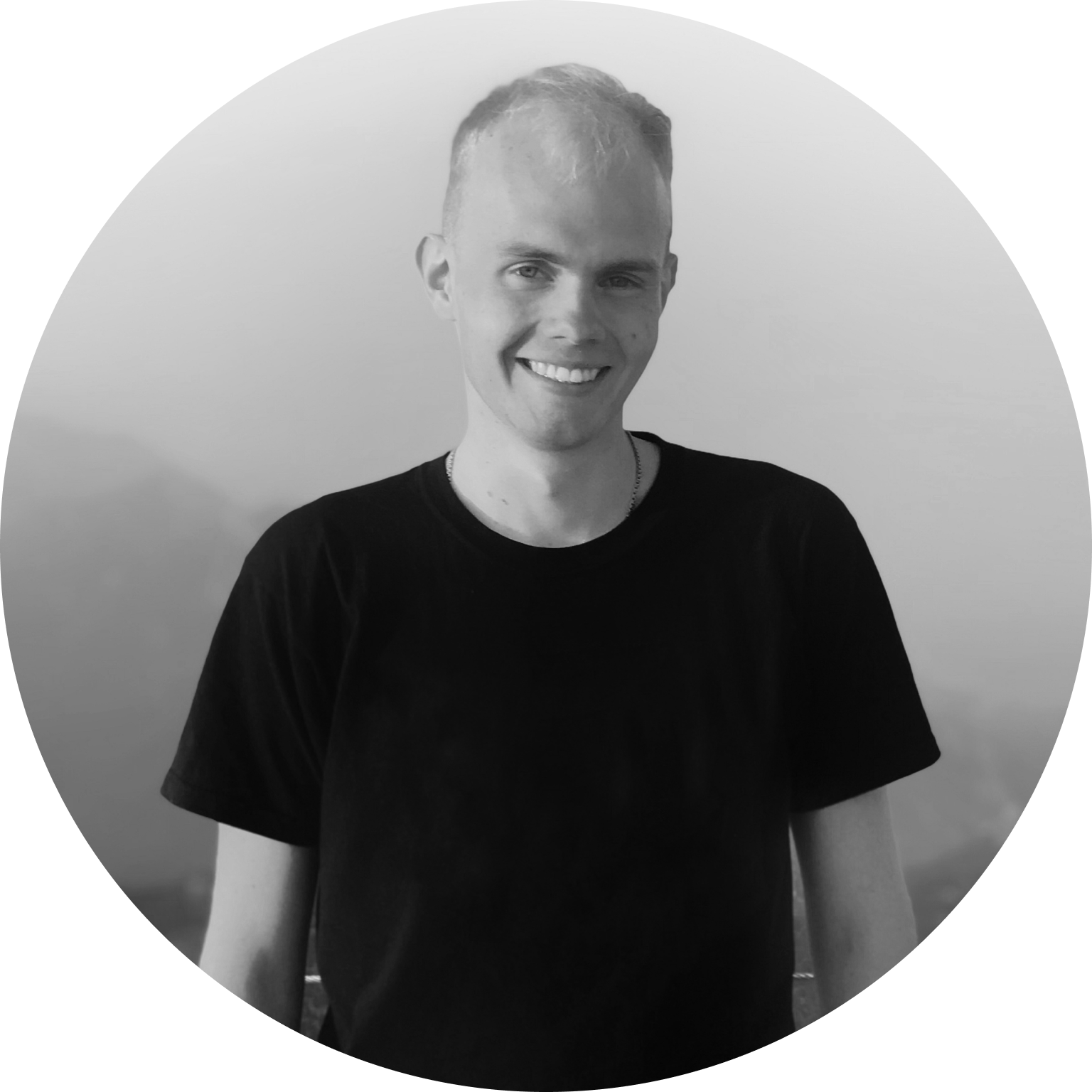The mobile app industry is booming! Thanks to growing internet usage and a smartphone nearly in every pocket, mobile apps have become indispensable for customer service.
Yet, the competition is fierce. More than 5.7 million apps are available on Google Play and App Store, and more than 485,000 mobile apps are downloaded every minute. To stand out, your mobile app should be fast, smart, and fit customers’ needs better. AI application development can be the solution.
People eagerly use AI for their routine operations: about half of Americans are interested in algorithms to conduct online searches, generate recipes, and use smart assistants. So, it is not surprising that the astonishingly rapid advancement of artificial intelligence technologies has been one of the key drivers supporting the mobile app market growth.
However, AI app development is one of the most challenging tasks in the software industry, and you may need help on your way to innovations. Having 17 years on the IT market, CHI Software is ready to offer a helping hand.
We have compiled a consolidated guide to walk you through the main technical aspects of AI mobile app development and help you figure out how to create an AI app from scratch to success.
This article covers the following:
- Information on the recent trends in the AI sector and industry-related statistics;
- The most popular feeatures you can find in AI apps;
- The benefits you get after implementing artificial intelligence in your mobile app;
- Tech stack required to build AI-powered applications;
- The four key steps of developing any AI app;
- AI app development cost explained;
- CHI Software’s tips and expertise.
AI Mobile App Development Is a Trend for 2024
Just a decade ago, we mostly knew about AI from sci-fi movies and far-fetched concepts, and today mobile AI changes how we use our phones, surf online, communicate, and shop.

AI in mobile apps through the years: what has changed in one decade
The first AI-enhanced mobile features appeared in the 2010s, and the iPhone was one of the first smartphones benefiting from innovations. The first AI-powered iPhone feature was text prediction. It used machine learning to guess the next word a user would type.
Today, we use algorithms every day without even noticing it:
- AI powers predictive text, autocorrect, and smart compose features that save our time typing;
- Voice assistants like Siri, Google Assistant, and Alexa help us get things done hands-free;
- AI enables face unlock, photo tagging, and other features in social media apps and optimizes routes in navigation apps like Google Maps and Waze.
Bringing AI into the hands of regular consumers has left a very positive response over the years. A lot more startups and big companies decided to implement AI in their products, especially mobile apps.
We see the AI app sector forecasts annual revenue to be 11,3 billion USD by the end of this year. In addition to this, mobile app consumer spending worldwide is projected to be 139 billion USD in 2024, reaching 185 billion USD in 2027.
With each new iteration of AI, the technology behind it becomes more beneficial for companies and users at the same time. You can see these mobile AI implementations pretty much everywhere:
- Personalized recommendations;
- Chatbots and virtual assistants;
- Image and video recognition;
- Augmented and virtual reality.
Let’s look at them more closely, taking into account successful real-market applications.
7 Features to Build AI-Powered Mobile Apps
One can hardly find more promising technologies than artificial intelligence and its subset machine learning (ML). Let’s review the most common implementation scenarios by starting with recognition technology.

This AI functionality can significantly boost your app’s user engagement.
1. Image Recognition
Image recognition is a subcategory of machine vision that helps distinguish objects inside an image.
To train image recognition models, AI app developers use deep learning techniques. They prepare a data set to introduce objects to an image recognition system. Of course, machines see things differently: every image is a set of pixels for them. Developers apply feature extraction to present object patterns in the form of vectors so that machines could “see” objects properly.
Interestingly, this technology mimics the mechanism of how animals detect objects but in a more computerized way.
Computer vision-based app for a cosmetic retailer
To help shoppers make buying decisions, our client, a cosmetic retailer from the US, decided to build an AI mobile app. It should analyze customers’ selfies, examine their needs, and recommend products that serve them best.
In response to these requirements, CHI Software developed a mobile app based on Computer Vision, photo face recognition, and ChatGPT capabilities.

This CV-based app also includes ChatGPT integration for better interactions with users.
So how does it work? First, a person takes a selfie with the app. Then, the AI-based mobile app identifies a face in the photo and analyzes it. Generally speaking, the app compares the image to numerous samples in its huge library to specify the problem and find possible solutions. Users can give more information by text or voice to achieve better results.
Based on the data received, the app generates personalized recommendations. ChatGPT-based chatbot wraps all the useful data in a friendly chit-chat with a user. This way, a person can express concerns and doubts and receive more detailed explanations. The app also collects feedback to improve the model for more satisfying results in the future.
Other examples of apps with image recognition:
2. Facial Recognition
Facial recognition helps identify and verify a person’s face on the image or video, determine if a face image belongs to one or two different persons, and search for human faces in a collection of images.
AI solutions created with the help of facial recognition usually have security purposes. Face ID, for example, is one of the most commonly used applications of this technology now available on many smartphones by default.
Face recognition service for kindergartens
CHI Software created a face recognition app for one of our Japanese clients who provides photo services at schools, camps, kindergartens, and children’s events. Our task was to create an app helping preschool workers provide better reporting on the time that a child spends at a preschool facility.
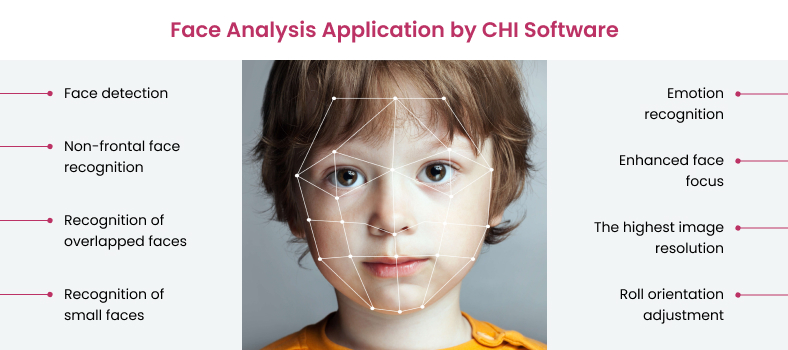
Such apps always require robust security measures.
The solution’s flow is the following:
- Registration: the child’s photo is uploaded to the system;
- Labeling: the solution compares detected face images with the ones in the database in real time;
- Reporting: parents get quick and detailed reports about the child’s condition.
Other examples of apps with facial recognition:
3. Voice Recognition
Voice AI for mobile phones is presented in the form of digital assistance. Using voice and speech recognition technologies, apps can understand what was said and how to react to a given command.
Virtual assistance is not exactly new on the market, and the niche continues to grow. Customers realize how much time they save using only their voice, while people with disabilities can accomplish a wider range of actions with their smartphones.
HOUND
Available for iOS and Android users.
It is a complex mobile application for voice search and commands. It can tell the weather forecast, navigate a route, find a location on the map, start playing a Spotify playlist, and many more.

Hound app’s interface
A special Houndify platform, combining automatic speech recognition (ASR) and natural language understanding (NLU), allows app creators to achieve high answer speed and accuracy.
Other examples of apps with voice recognition:
4. Chatbots
As competition on the mobile app market becomes more severe, companies are working hard to perfect existing customer experiences. An AI-based text assistant (chatbot) available 24/7 is one of the vital workflow additions.
These smart instruments can process user queries and respond to typical questions with the help of natural language processing (NLP).
NLP is a combination of natural language understanding (NLU) and natural language generation (NLG), allowing robots to have conversations with humans.
Mobile app with an interactive AI chatbot
CHI Software created an entertaining app with a chatbot in the form of a funny character, an emperor penguin. Our client, a leading Japanese telecommunication company, aimed to add an entertaining aspect to routine processes and increase user engagement.
The app contains a home page, chat bar, vocabulary mode, and user profile. The more the penguin talks to users, the more new words it learns daily.

This is another chatbot where we incorporated OpenAI API for the best and fastest results.
Key app characteristics:
- The penguin character moves depending on the time of the day and upon the user’s touch;
- The character will use AI technology implemented on the server side;
- Push notifications inform users about news and updates;
- To chat and view news, the user is redirected to the web view.
Other examples of apps with chatbots:
5. Automated Reasoning
Using automated reasoning, mobile applications solve current issues based on historical data. Something that happened some time ago automatically brings insights and solutions to this very moment.
Any automated reasoning framework requires four parameters:
- Problem Domain: what issue exactly a system must solve;
- Language: what logic and programming language a system must use;
- Deduction calculus: what tools and process a system must implement to analyze information;
- Resolution: how to control the overall flow.
Navigation systems are the most obvious examples of applying automated reasoning techniques.
Uber
This world-famous taxi service doesn’t require a detailed introduction, so we’re looking closer at its automated reasoning feature.
The app’s algorithms process information about every ride to create optimal routes. Based on the collected data, users can check the distance to available drivers and how long their trip will take, considering the time of the day.
This is real-time reasoning based on previous experience, i.e., automated reasoning.
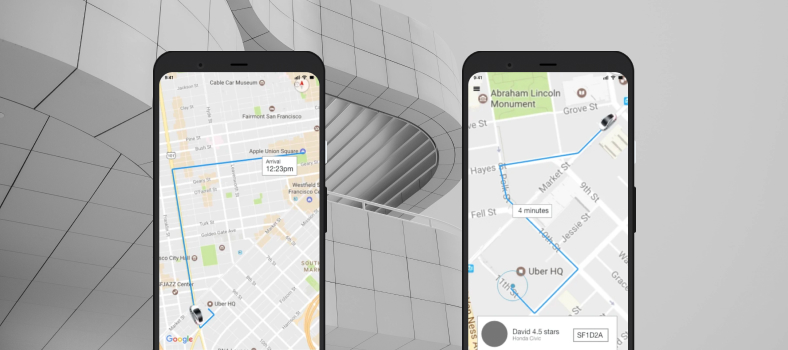
Uber’s automated reasoning feature
Other examples of apps with automated reasoning:
6. Neural Machine Translation
Using AI in mobile apps for translation seems an obvious solution. Every language is a large data set of words, so algorithms learn several of such data sets and how they correspond with each other. This type of translation is called neural machine translation.
Traditional machine translation interprets every word in a sentence ignoring the overall context. AI and ML in mobile app development enable understanding phrases, sentences, and even tone of voice, which significantly improves translation quality.
Memsource Mobile
Available for iOS and Android users.
Memsource is a complex online platform powered by patented AI technology, helping managers and translators cope with their regular translation tasks. Memsource Mobile, in turn, enables translation on the go, regardless of the user’s location.

Machine translation by Memsource
As of September 2022, the platform supports 500+ languages and 50+ file types and covers the niches of marketing content, software & apps, documentation, e-commerce websites, and games.
Other examples of apps with neural machine translation:
7. Advanced Personalization
By advanced personalization, we mean multifactor examining user behavior (based on a history of orders, location, account settings, etc.), providing a unique and engaging in-app experience.
According to McKinsey, 76% of consumers would opt for brands that prioritize personalized messaging and offerings. It’s highly likely that AI personalization will soon become the first choice for big and mid-sized businesses.
Starbucks
Available for iOS and Android users.
Starbucks, among other global brands (Spotify, Amazon, Instagram, Netflix, etc.), actively uses high-end personalization features. Customers feel like the app knows and understands them, so they easily get hooked.
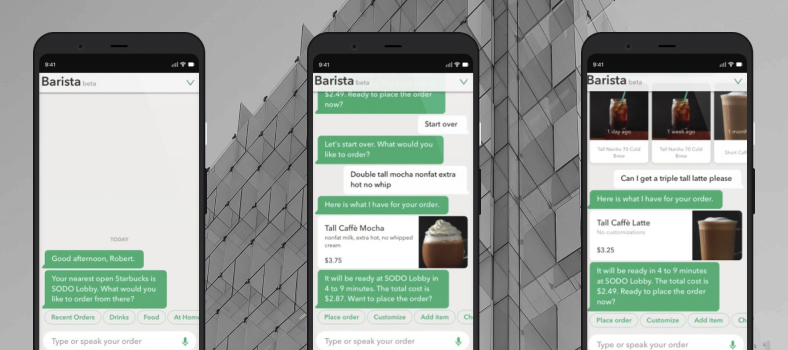
How Starbucks’ personalization works
To make it possible, Starbucks applies behavioral segmentation. As the name suggests, the app studies user behavior patterns and habits to deliver customer-centered offerings, hitting straight to the point.
Moreover, this approach allows the company to troubleshoot any user experience gaps and optimize the workflow in the shortest terms.
Other examples of apps with advanced personalization:
What Are the Benefits of Implementing AI in Mobile Apps?
The rapid development of AI technologies gives vast possibilities for transforming the mobile experience. Today, many apps provide AI-enhanced features for learning languages, getting new contacts, choosing what to cook for dinner, and unlocking devices with biometrics. With AI, mobile apps become more engaging, exciting, and empowering.
As mobile apps with AI-enhanced functionality appeal to users, businesses can utilize their emotional power to achieve numerous benefits.
The advantages companies can gain vary a lot. We can categorize them as follows:
- Improved user experience through deep personalization of content, ads, and recommendations.
- Automation of day-to-day tasks helps reduce costs and decrease the chance of human-made mistakes.
- Increased efficiency in operations, data processing, and customer support.
- New revenue stream opportunities due to better recommendations and consumer satisfaction.
- Enhanced security of sensitive data and mobile apps in general.
Our experience proves that adopting AI to a mobile app naturally increases brand awareness and perception. Users like and warmly greet innovative, smart, and intuitive apps that understand them and serve their needs better.
Want these and other benefits of AI for your app? We will help you achieve what you are striving for at a reasonable cost
Contact us
Tech Stack for AI Application Development

Of course, there is no universal tech stack that fits every case of AI mobile app development. Our team determines the technologies for any project exclusively, considering requirements, desired features, and best development practices. So, how to make an AI app?
Programming Languages, AI Platforms, and Libraries
Most artificial intelligence applications you see in the world were written in one of these programming languages. Let’s take a look at them one by one:
Python is considered a great programming language for beginners. But being simple to understand isn’t the only strong side of it. It is also a powerful tool for data analysis, with a great number of libraries to analyze and classify large datasets, making it perfect for AI solutions.
Java is one of the most popular programming languages out there, so it’s no wonder programmers use it in AI development. On top of its simple debugging and maintenance, Java is multi-platform, which is great for mobile app development. Actually, most mobile apps are written on Java, and that includes AI-based applications.
The biggest advantage of C++ is its speed and efficiency. Since many AI applications are complex, using a programming language that can execute code fast will improve the speed of AI processing. At the same time, speed and efficiency come with a complex code structure.
These are the most popular programming languages. However, in some cases, engineers can also turn to C#, R, Lisp, or Prolog.
To optimize development costs, our software engineers use third-party AI and Machine Learning (ML) platforms, including the most popular ones:
- Google TensorFlow is an innovative data science environment for numerical computation using dataflow graphs and creating AI-based projects from idea to launch. The functional and portable TensorFlow has a flexible architecture that allows computing to be deployed across multiple processors applying a common API.
- Microsoft Azure. The platform’s advantages are a wide range of algorithms, advanced analytical mechanisms, and high-quality multilingual documentation. AI/ML capabilities include predictive modeling, recommendations mechanism, natural language processing, pattern recognition, and other services.
- Amazon AWS helps to create, train, and deploy models and intelligent apps of any complexity. The platform is based on simple, scalable, and flexible ML technology, which is used, among other prominent engineers, by scientists from the Amazon community.
Other trustworthy AI platforms include IBM Watson, Oracle AI cloud services, Mendix low code platform, H2O, and Wit.ai.
Frameworks and Application Programming Interfaces (APIs)
AI, ML, and deep learning frameworks greatly simplify the development of complex, high-tech products and allow you to use third-party functionality. The most popular options are:
- Microsoft Cognitive Toolkit (CNTK) helps create various ML models, including recurrent and convolutional neural networks. Using the framework, we quickly process arrays of unstructured data, choose metrics and algorithms, and train machines to think almost like people.
- AWS Machine Learning assists in the development of highly complex applications with high performance. It can connect applications to cloud services and create forecasts using API.
- PyTorch. Combining the ML library, pre-trained models, and scientific computing structure, it allows us to quickly build complex systems such as deep neural networks. The Python-powered framework provides excellent flexibility and efficiency.
- Core ML/Create ML are well-suited for developing AI products for Apple devices in particular.
- Caffe2 helps build modular deep learning environments. ML’s open-source set of algorithms enables engineers to experiment with different models.
Other popular framework options are Keras, Accord.NET, scikit-learn, and SparkMLlib. Apart from frameworks, we use third-party APIs and software development kits (SDKs) )to speed up and optimize software development. The options include Azure Text Analytics API, Microsoft Face API, Google Vision API, Apple SiriKit, and others.
Need an individual solution for your domain? We will create a detailed development roadmap for your business idea
Contact us
How to Build an Artificial Intelligence App: Key Steps
Though some of the steps are repeated many and many times while developing an AI app, we follow the basic pipeline:
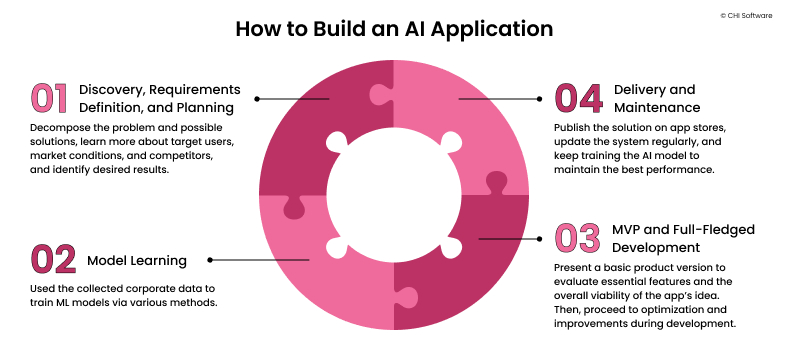
The four fundamental steps to build an AI app for any industry
Let us guide you through the details of every stage of how to make an AI app.
1. Discovery, requirements definition, and planning
To understand how to build an AI app, we need to identify the issue first: decompose the problem and possible solutions, learn more about target users, discover market conditions and competitors, and identify desired outcomes. The discovery phase depends on the client’s requirements, information on hand, and available documentation.
Once the idea and problem are defined, we create a clear list of product requirements. Properly written and structured, they help developers understand the purpose of creating a product and identify technologies and tools for working.
At the planning stage, we also:
- determine a team of technical and non-technical specialists,
- draw up a work schedule,
- start exploring the data required to create an AI/ML model.
2. Model learning
In order to build an AI app, it is required to have large amounts of well-prepared structured data to operate correctly. Therefore, software engineers carefully study input information and its sources, following the Cross-Industry Standard Process for Data Mining (CRISP-DM).
Next, we check input data for errors, missing values, or incorrect labels and move on to the data preparation stage, which requires:
- Selecting and uploading raw data,
- Picking annotation tools,
- Highlighting and labeling data blocks,
- Selecting and saving file formats.
The collected dataset allows us to compare solution options and proceed with the modeling stage. The previously collected data is used to train ML models via various methods. When the model is trained, we have to evaluate whether it is ready for deployment or needs further training. Once we have a model deployed, we integrate it into a mobile app.
Looking for advice on AI apps or ML models? Get profound consultancy and professional engineering services from our development teams
Contact us
3. MVP (Minimum Viable Product) and full-fledged AI-based app development
AI development projects at CHI Software are based on the Agile methodology. It means conducting many cycles of software development and testing one after another. This way, we can find gaps as early as possible and fully control the product’s high quality and market relevance. We are gradually moving from a minimum viable product (MVP) to a final solution to be presented to end users.
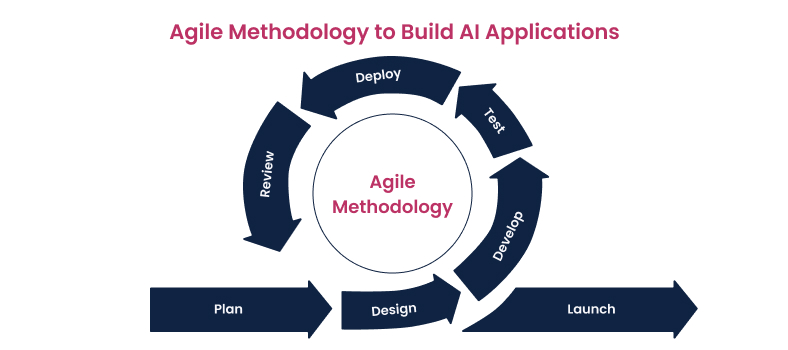
Any AI application is built iteratively by testing and trying out each new feature.
An MVP allows us to present a basic product version to evaluate essential functionality along with the overall viability of the app’s idea. In general, creating an AI-driven application is no different from a typical software development life cycle (except for CRISP-DM), so we have to:
- think over the solution’s architecture,
- design a user interface and user experience,
- work on the frontend and backend parts (user interface development and server-side development).
At the development stage, we optimize the app’s performance, improve and expand functionality, and adapt the product to mobile OS updates.
4. Delivery and maintenance
When our system is ready, we can deliver it or publish the application on app stores. For native apps, we use the Play Market guide for Android applications and AppStore recommendations for iOS products.
Maybe you need a guide on how to build any type of AI software from scratch? We have something for you
Follow this link
We strongly recommend updating the system regularly (so that it supports the latest OS versions) and improving models by adjusting and supplementing the previously collected data.
How Much Does It Take to Build an AI Mobile App? Time and Budget Explained
AI app development cost depends on many factors, such as features implemented, product complexity, a tech stack, and the number and rates of people involved. Budgets to build a chatbot and a corporate data analysis system are strikingly different. However, there are general rules to consider.
We have also drawn up the following list of extras:
- Type of AI mobile app you want to build: for instance, personal assistant or chatbot, Machine Learning, voice/text recognition, or process automation;
- Number of the required features in the app. The MVP version with limited features will cost less than a final product with more than 5 features;
- Number of app development platforms you need the app for: iOS, Android, or both;
- Number of third-party APIs used in the app;
- Software requirements specifications;
- AI mobile app security requirements;
- AI app maintenance and support.
Hourly Breakdown of AI App Development
Now that we know the factors that influence the AI mobile app price, let’s see how to calculate the cost for your application.
The table below demonstrates every app development stage and its corresponding timeline.
Important note: below are the stages of AI app development using ready-made libraries that solve typical ML tasks, for example, Google’s ML Kit. Deep AI expertise is not needed to work with such libraries. It is a conventional development.
As for more complex, custom ML solutions, they are solved in cycles, so as a rule, the total cycle quantity and result cannot be guaranteed and estimated in advance.
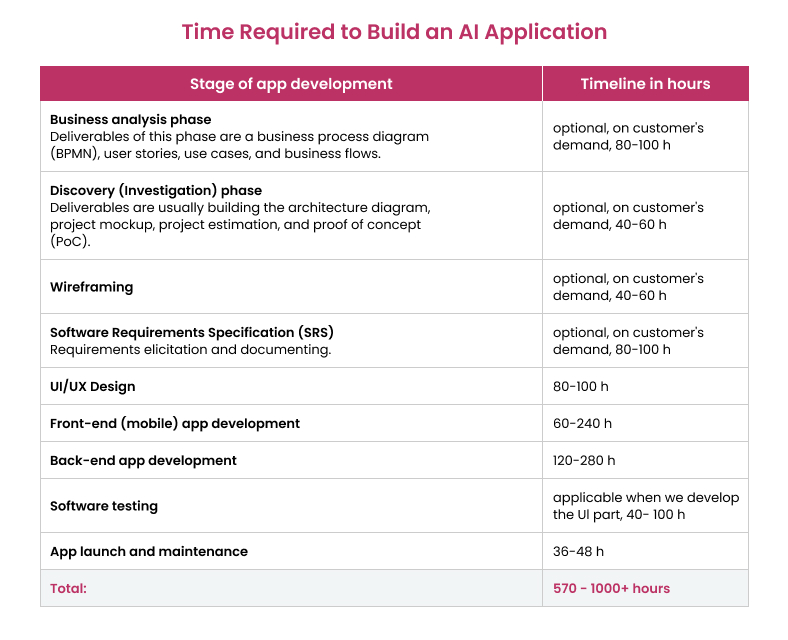
The number of hours required from each team member when working on AI applications.
Below, we placed an easy and effective formula we use in our projects, i.e., the estimated hours or time required to build a smart AI app multiplied by the software developer’s hourly rate.
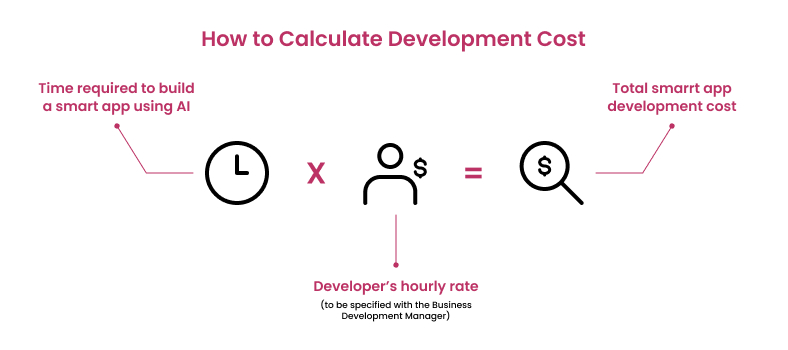
This calculation formula will be helpful for any type of development, including AI-based.
From our experience, it takes about three months to develop a simple AI app. However, if we talk about an end-to-end solution with rich functionality, it will take about twice as long. Extra factors, such as data visualization, the minimum accuracy rate for predictions, and dashboard requirements, can add to the time and, therefore, the cost of development.
We have analyzed our AI mobile expertise and concluded that the average Artificial Intelligence mobile app development at CHI Software costs between USD 16,000 and USD 40,000 with the minimum iteration of USD 5,000 – USD 6,000.
App support is another unavoidable cost, which represents around 30 percent of the development budget for the first year post-launch and 15-25 percent per year afterward.
Tell us about your idea and get a quick estimate of time and money cost to develop an AI app from scratch
Contact us
How Can CHI Software Help?
The AI and ML unit of CHI Software was created back in 2017. Now, with seven years of expertise on commercial projects, the team can handle any innovative challenge.

Our AI expertise includes, but is not limited to, the following:
- Data Science,
- Machine Learning,
- Computer Vision,
- Natural Language Processing,
- Signal and Audio Processing.
AI Engineers and Data Scientists use, in one form or another, the CRISP-DM methodology in their work. The main difference between this methodology and the conventional development mentioned above is cyclicality. It means, we can estimate the time spent per cycle, but we cannot predict how many cycles it will take to achieve the required results, nor can we guarantee their achievability.
The core services for business we provide:
- Scientific research and consulting;
- Full-cycle software products development;
- Integration of ready-made AI solutions to your business;
- Initial AI solutions improvement;
- Improvement of user targeting, risk management, and forecasting.
Our in-house AI and ML experts are Technical Leads, Data Scientists, ML Engineers, MLOPs, Software Testers, Business Analysts, and Project Managers.
Let’s have a look at yet another AI-powered technology – Computer Vision. Since Computer Vision (CV) takes one of the leading roles in our smart applications, let’s have a closer look at the most popular CV tasks, and how they are realized in a real product.
List of computer vision tasks for AI-powered solutions:
- Object detection,
- Segmentation,
- Image classification,
- Object tracking,
- Object recognition,
- Optical character recognition,
- Facial recognition and analysis,
- Image generation,
- 3D reconstruction,
- Parsing table or structures,
- Sensor fusion,
- Navigation by visual markers.
Conclusion
Artificial intelligence has been landing on mobiles. AI app development solutions help people be more productive, creative, and efficient in their daily chores and activities, so unsurprisingly, AI is warmly greeted by mobile users.
We have also covered how to build an AI application. Adding AI features to your mobile app is a great way to overdo the competitors and gain a market advantage. Who would not want that?
To understand the latest AI trends and reach your goals right away, you need a professional AI app development services. The expertise of experienced software developers and business analysts can work miracles. So get the ball rolling!
Book your free consultation right now! Regardless of the size and available budget, we will help your business idea stand out.
FAQs
-
Is it possible to make an app with AI?

Sure! You can use a special AI-powered app builder with ready-made features or create a solution from scratch with the help of professional developers. Each approach has pros and cons and should be considered individually.
-
What is an AI application?

An AI application is a mobile tool that uses AI capabilities to perform a part or all of its tasks.
-
What is AI mobile app development?

It is a process of developing applications with artificial intelligence features, which, among other things, allow companies to create a previously unachievable user experience.
-
How much does AI app development cost?

The minimal budget to build an AI app is 10,000 USD, but generally, the cost is between 30,000 USD and 100,000 USD and heavily depends on software requirements and desired business results.
-
What is the best AI app development company?

There is no perfect AI company for every business. The final decision depends on your budget, corporate culture preferences, and even team mentality.
We suggest you pay attention to the vendor’s successful use cases and process transparency. CHI Software, for example, has been developing AI for various industries. We are also an ISO-certified company prioritizing data security on every project.
-
What are the best AI apps?

AI apps usually serve different industries and niches, so it is better to determine the best solution in a particular category. For example, it is eBay in retail, Cleo in fintech, Spotify in media & entertainment, ELSA Speak in education, etc.
The success of any AI app relies on algorithm abilities. It should be trained on the well-structured app data, considering every user maneuver within an app. Training a robust algorithm, as a rule, takes some time, so the longer you work in the niche, the more intelligent your app becomes.
About the author
Alex Shatalov
Data Scientist & ML Engineer
Alex is a Data Scientist & ML Engineer with an NLP specialization. He is passionate about AI-related technologies, fond of science, and participated in many international scientific conferences.

















